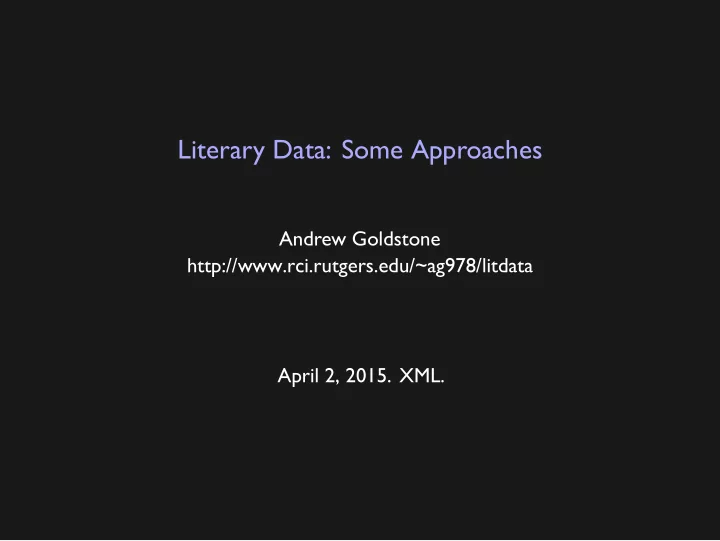

Literary Data: Some Approaches Andrew Goldstone http://www.rci.rutgers.edu/~ag978/litdata April 2, 2015. XML.
sapply sapply(xs, f, ...) lst <- list(c("Charles", "Simic"), c("Edmund", "Spenser"), c("Wallace", "Stevens")) lapply(lst, str_c, collapse=" ") [[1]] [1] "Charles Simic" [[2]] [1] "Edmund Spenser" [[3]] [1] "Wallace Stevens" ▶ xs can be a list or a vector ▶ provided f yields a single value, returns a vector (not a list) ▶ whatever’s in ... is passed on to f each time
sapply(lst, str_c, collapse=" ") [1] "Charles Simic" "Edmund Spenser" [3] "Wallace Stevens"
XML ▶ plain-text format ▶ all markup in between <...> ▶ markup structures text in strict hierarchy
</teiHeader> <title>Lady Audley's Secret, Volume 1</title> </fileDesc> ... </titleStmt> ... </author> <author>Braddon, M.E. (Mary Elizabeth) (1837-1915) <titleStmt> XML: <fileDesc> <teiHeader> node: text node: <tag/> node: <tag>node*</tag> node grammar
<tag>: <tagname attrs*> <tag/>: <tagname attrs* /> attr: attrname="attrvalue" <head>CHAPTER I.</head> <pb n="6" xml:id="VAB7086-010"/> attributes <head type="sub">LUCY.</head>
<l><sentence> The apparition of these faces in the crowd;</l> <l>Petals on a wet, black bough.</sentence></l> the rule What is wrong with ?
extras ▶ comments <!-- comment --> ▶ processing directives: <? ... ?> ▶ <?xml version="1.0" encoding="utf-8"?> ▶ unparsed: <![CDATA[...]]> ▶ entities: Toronto: Bell & Cockburn
The Text Encoding Initiative (TEI) ▶ defines a set of XML tags and attributes ▶ text as “ordered hierarchy of content objects” ▶ Guidelines (www.tei-c.org/Guidelines/P5/): only 1664 pages! ▶ TEI Lite (www.tei-c.org/Guidelines/Customization/Lite/): fewer tears
<?xml version="1.0" encoding="utf-8"?> <!DOCTYPE ETS SYSTEM "http://www.lib.umich.edu/tcp/docs/code/eebo2prf.xml.dtd"> <ETS> <TEMPHEAD> <REVDESCR> ... library("XML") xmlName(congreve_root) [1] "ETS" getting to grips in R congreve <- xmlParse("tei-sample/ecco/K001985.000.xml") congreve_root <- xmlRoot(congreve) # top of the hierarchy
class(congreve) [1] "XMLInternalDocument" [2] "XMLAbstractDocument" class(congreve_root) # hmm [1] "XMLInternalElementNode" [2] "XMLInternalNode" [3] "XMLAbstractNode" more design principles: encapsulation
congreve_root[[1]] <TEMPHEAD> <REVDESCR> <CHANGE> <DATE>2008-09-19</DATE> <RESPSTMT> <NAME>Simon Charles</NAME> <RESP>MURP</RESP> </RESPSTMT> <ITEM>Proofed and reviewed</ITEM> </CHANGE> </REVDESCR> </TEMPHEAD> more design principles: polymorphism
[1] "Simon Charles" "EEBO" xmlValue() "RESPSTMT"]][["NAME"]] %>% congreve_root[["TEMPHEAD"]][["REVDESCR"]][["CHANGE"]][[ <NAME>Simon Charles</NAME> "NAME"]] "RESPSTMT"]][[ "CHANGE"]][[ "REVDESCR"]][[ congreve_root[["TEMPHEAD"]][[ "TEMPHEAD" kids <- xmlChildren(congreve_root) EEBO TEMPHEAD sapply(kids, xmlName) [3] "XMLAbstractNode" [2] "XMLInternalNode" [1] "XMLInternalElementNode" # oookay class(congreve_root) # next level down traversing the tree
[1] "XMLNodeSet" [[1]] attr(,"class") <NAME>Simon Charles</NAME> [[1]] getNodeSet(congreve_root, "//NAME") [1] "XMLNodeSet" attr(,"class") <NAME>Simon Charles</NAME> getNodeSet(congreve_root, "/ETS//NAME") [1] "XMLNodeSet" attr(,"class") <NAME>Simon Charles</NAME> [[1]] "/ETS/TEMPHEAD/REVDESCR/CHANGE/RESPSTMT/NAME") getNodeSet(congreve_root, extracting node sets ▶ XPath: like file paths! ▶ but shorter!
speakers <- getNodeSet(congreve_root, "//SPEAKER") length(speakers) [1] 1162 class(speakers) [1] "XMLNodeSet" spkr_names <- character() for (i in seq_along(speakers)) { spkr_names[i] <- speakers[[i]] # sloooow } and…vectorized Could do:
spkr_names <- xmlSApply(speakers, xmlValue) Val. Ang. 113 133 165 171 Tatt. Sir Samp. Scan. head(spkr_names) spkr_names sort(table(spkr_names), decreasing=T)[1:5] [6] "Jere." "Jere." "Val." "Jere." "Val." [1] "Val." 97
[1] 5 [7] "act" length(acts) acts <- getNodeSet(congreve_root, '//DIV1[@TYPE="act"]') # An XPath can match attributes: [11] "act" "act" [9] "act" "act" "dramatis personae" divs <- getNodeSet(congreve_root, "//DIV1") [5] "epilogue" "prologue" [3] "prologue" "dedication" [1] "title page" xmlSApply(divs, xmlGetAttr, "TYPE") [1] "title page" xmlGetAttr(divs[[1]], "TYPE") attributes
crisis <- xmlParse("tei-sample/mjp/Crisis130_22.2.tei.xml") all_divs <- getNodeSet(crisis, "//div") length(all_divs) # what. [1] 0 xmlNamespaceDefinitions(crisis)[[1]][c("id", "uri")] $id [1] "" $uri [1] "http://www.tei-c.org/ns/1.0" namespaces: a pain in your neck
# "def" is arbitrary here front 1 poetry issue 2 1 images 6 all_divs <- getNodeSet(crisis, "//def:div", 4 articles advertisements . xmlSApply(all_divs, xmlGetAttr, "type") %>% table() namespaces=c(def="http://www.tei-c.org/ns/1.0")) 1
ns <- c(def="http://www.tei-c.org/ns/1.0") namespaces=ns)[[1]] poem <div type="poetry"> <ab>THE NEGRO SPEAKS OF RIVERS </ab> <ab>LANGSTON HUGHES </ab> <ab>I'VE known rivers: I've known rivers ancient as the world and older than the flow of human blood in human veins. </ab> <ab>My soul has grown deep like the rivers. </ab> <ab>I bathed in the Euphrates when dawns were young. </ab> <ab>I built my hut near the Congo and it lulled me to sleep. </ab> <ab>I looked upon the Nile and raised the pyramids above it. </ab> <ab>I heard the singing of the Mississippi when Abe Lincoln went down to New Orleans, and I've seen its muddy bosom turn all golden in the sunset. </ab> <ab>I've known rivers; Ancient, dusky rivers. </ab> <ab>My soul has grown deep like the rivers. </ab> </div> poem <- getNodeSet(crisis, "//def:div[@type='poetry']",
# h/t Nicole fe <- xmlParse("fair-em/A21328-sheriko.xml") speeches[[1]] <sp who="Lubeck"> <speaker>Marques.</speaker> <l met="100">WHat meanes faire Britaines mighty Conqueror</l> <l met="100">So suddenly to cast away his staffe?</l> <l met="100">And all in passion, to forsake the tylt.</l> </sp> more with attributes speeches <- getNodeSet(fe, "//def:sp", namespaces=ns) ▶ How can we tally proportions of metrical deviations by speaker?
# not fast meters <- xmlApply(speeches, getNodeSet, "def:l", namespaces=ns) %>% lapply(xmlSApply, xmlGetAttr, "met", default="<missing>") for (j in seq_along(speeches)) { s <- speeches[[j]] if (length(meters[[j]] > 0)) { default="<missing>"), meter=meters[[j]]) } } ll <- vector("list", length(speeches)) ll[[j]] <- data_frame(sp=xmlGetAttr(s, "who", spkrs_meter <- do.call(rbind, ll)
metrical_devs <- spkrs_meter %>% group_by(sp) %>% summarize(total_lines=n(), deviations=sum(meter != "100")) %>% mutate(dev_pct=deviations / total_lines * 100) %>% arrange(desc(dev_pct))
metrical_devs %>% print_tabular() sp total_lines deviations dev_pct Manuile 1 1 100 Elner 16 15 94 Citizen 26 21 81 Messenger 10 8 80 Trotter 45 36 80 < missing > 4 3 75 Rosilio 4 3 75 Ambassador 10 7 70 Mariana 85 52 61 Valingford 125 71 57 Em 189 104 55 Goddard 118 57 48 Demarch 34 15 44 Manvile 93 38 41 Blanch 33 13 39 Lubeck 124 46 37 Soldier 11 4 36 William 246 80 33 Zweno 118 34 29 Mountney 109 28 26 VVilliam 6 1 17 Dirot 5 0 0 Miller 2 0 0 William 2 0 0
html ▶ really just like XML ▶ except when it isn’t ▶ (homework)
Recommend
More recommend